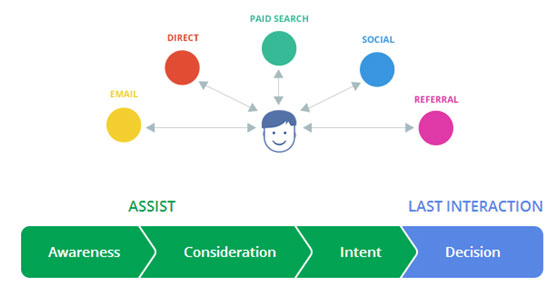To operate on an open, global market, it is necessary to rethink the strategies by which products and services are sold and distributed, adopting new competitive skills.
Even the most well-known brands cannot rely on the competitive advantages and the marketing levers adopted in the past, but they must organise themselves according to more modern and more flexible strategies.
GSA offers itself as the ideal partner to design, develop and promote integrated marketing plans in which traditional advertising campaigns are accompanied by innovative, multi-channel digital advertising initiatives (web, social network, mobile, etc.).
A new sales paradigm
GSA has the means, the skills and the solutions to face a new sales paradigm coming from the web: focus has now shifted to the consumer which has become the major influencer in the purchasing process.
The opinion of a consumer – who has already bought a product or a service – and who shares his experience on the web – with comments and photos in the social networks, articles, blogs, forums etc. – has become one of the most important factors which can influence the purchasing process.
Thus, there is no longer a clear distinction between consumers of contents and suppliers of contents; on the contrary, the mechanism has been completely upturned: most contents which speak of a product or a service are generated by the consumers themselves and not by those appointed to deal with promotion through advertising and marketing campaigns.
Opinions exchanged by “word of mouth” are increasingly more “digitalised” and the social networks are like digital amplifiers.
• 51% of users in Italy leaves a comment on a product on-line after buying it
• 60% of on-line customers in Italy, before buying a product, checks on the opinions of other users, obtaining the benefit of reassurances, clarity and convenience. Source: Global Web Index
• For 70% of consumers, word of mouth is the most important factor in the purchasing decision process. Source: Nielsen data 2012
Not only advertising
Most of marketing budgets are spent on institutional advertisements, on and off line. Speaking only in an institutional manner is no longer sufficient; it is also necessary to know how to manage and influence the information flows and the web contents generated by consumers in a positive way for the company’s image.
therefore it becomes fundamental to interact with present and potential customers:
• to maximise the awareness of a product or service, for example by initiatives aimed at involvement/engagement;
• to hear, monitor and possibly influence consumers’ opinions and judgements (user generated contents), stimulating the spread of positive comments and messages and promptly reacting to any negative feedback.
The reputation, trust and loyalty towards a “brand” depend mainly on this. Not to listen, not to intervene, not to “play” with these new rules means the dispersion of energy and of economic resources and losing potential customers.
“Happy and satisfied customers are our most important marketing resource”
More Participation = more visibility = more sales
A multi-channel approach
GSA supports and develops multi-channel promotional strategies. The purchasing process (whether on or off line) is in fact a path composed of several steps and involving several channels. The diverse marketing channels (e-mail, advertisements, direct marketing, social media marketing, etc.) influence the potential buyer at different points of the path which lead to the purchase. We can speak of a decision-making process which is like a real “purchase funnel” which leads the consumer towards the purchase and which can vary considerably according to the product and the market addressed.

The social networks should be part of the marketing
GSA strongly supports the inclusion of the social networks in the promotional media mix. We have seen that the path towards the sale is not linear, as it used to be in the past. One has to be in a position to control all the channels in which the purchase decision can be influenced. The social networks, in particular, are the step where most of the interaction between consumers takes place and where opinions (positive and negative) are spread by “word of mouth” most easily. To be present in a social network does not mean having an extra sales channel. The main purpose of entering the social networks must not be to sell but to arouse curiosity and interest. In fact, social networks serve to approach the target, to listen to, to answer, to dialogue with and to assess the target, to understand what it needs and what interests it, and to guide it gently and discreetly towards the purchase. In the social networks, the consumers meet to chat and to have fun, and to share their emotions and moods: a modern environment which takes the place of the village square or the ancient agora.





